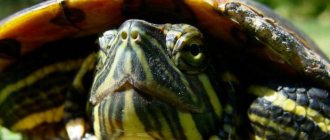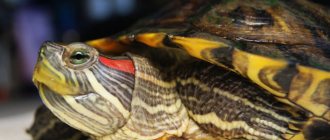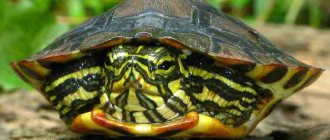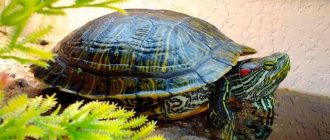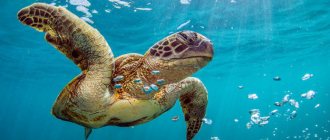Molting time for red-eared turtles
Do not be alarmed when the red-eared slider begins the molting process. This is a natural process that occurs in a young individual during a period of active growth. The reptile grows quite quickly and the shell simply cannot keep up with its growth. Therefore, all or part of the shell peels off. This process is absolutely safe for the turtle, but during this period it needs special care.
A turtle in the early stages of its development may experience complete peeling of the top layer of its shell. As the turtle matures, the amount of dead tissue decreases. This is no longer the entire upper layer of the reptile’s shell, but only part of it. After some time, the red-eared slider's molting stops.
Pathological causes of soft shell
The dorsal shield of the shell in babies is bright green. With age, its color becomes darker, olive green. You can see black and yellow stripes on it. The ventral shield is dark in color and has black spots on it. These age spots on the red-eared slider's shell are a variant of the norm. At the same time, the shell is hard to the touch.
When it becomes soft and its separation is observed in an adult reptile, this is a symptom of pathology.
Often, a reptile has not only a soft shell, but a number of other signs:
- redness and swelling of the eyes;
- heat;
- the edges of the shell bend, its particles begin to peel off.
Such signs can be observed in various pathologies: dysfunction of the thyroid gland and intestines. The hardness of the shell depends on the amount of calcium in the reptile's body. The lack of this mineral causes the pyramidality of the carapace and a number of other signs and the development of rickets. The structure of the skull bones is disrupted, as a result the reptile cannot eat.
A lack of calcium in the body can be caused by dysfunction of the intestines and kidneys, which causes a deterioration in the absorption of the mineral. A deficiency of UV rays leads to a lack of vitamin D, which can also cause softness and peeling of the carapace tissue.
If your pet's shell peels off, this may be a sign of mycosis. With a fungal infection, a white coating may be observed on the shell of the red-eared turtle. White stripes can also remain on objects that the reptile rubs against. Also, when there is a fungal infection, the red-eared turtle scratches its shell.
In addition, white spots on the shell of a red-eared turtle can be observed if:
- the water in the aquarium is hard;
- improper feeding of the turtle;
- shell injuries;
- incorrect lighting.
Soft shells, bruises and an unpleasant odor can be observed due to burns and trauma to the shell, which are complicated by a secondary bacterial infection. In this case, the pet is treated with antibiotics.
If the reptile looks sick, you need to show it to a herpetologist as soon as possible, who will determine why the shell of the red-eared turtle is peeling off, it has become soft and will tell you what to do and how to help the animal.
Features of caring for your pet during the molting period
During the molting period of your pet, special attention should be paid to its nutrition. There is no need to radically revise your diet or change your diet. It is enough to add products containing calcium and vitamins to it. To replenish the loss of these substances, it is recommended to give the turtle small fish or crustaceans. You can also buy food for young turtles in specialized stores.
Also during the molting period, it is important to monitor the cleanliness of the turtle’s home and the aquarium. The thing is that dying shell particles float on the surface, thereby polluting the water. Dirty water is a favorable environment for the development of bacteria. Therefore, you should change the water as often as possible or install a filter in the aquarium.
Some owners try to speed up the molting process of their turtle by forcibly removing the top layer of the shell. This is strongly not recommended. You can help remove a layer of shell if the turtle cannot do this on its own for a long time. A shell that does not peel off is uncomfortable for the turtle and can cause injury and poor health.
To speed up the molting process, you can gently wipe the shell with a decoction of chamomile flowers. You can remove the turtle from the aquarium for a while and let it dry completely. Dry scales will peel off more easily and fall off as the turtle crawls or swims in the aquarium.
During the molting period, experts advise bathing turtles to remove remaining dirt from under the shell scales and prevent them from rotting. For swimming you will need a small container with low sides. Fill it with warm water and add baking soda at the rate of 1 teaspoon per liter of water. Carefully lower the turtle into the container so that its head remains on the surface. After 20 minutes of taking a bath, take it out, carefully blot off excess water with a towel and apply a few drops of olive oil to the shell.
Treatment
Therapy should be prescribed depending on the diagnosis.
If the reason for the softness of the carapace and plastron is a deficiency of calcium and vitamin D, then in the warm season the animal and its terrarium can be taken outside. In this case, it is necessary to protect the reptile from direct exposure to the UV rays of the sun.
In winter and autumn, the aquaterrarium along with the reptile should be placed under a UV lamp, but the animal’s eyes should first be covered with a plaster. This is necessary so as not to damage the lens and retina of the reptile. Exposure to ultraviolet rays should not exceed 5 minutes. The procedure must be carried out 3 times a week.
For inflammation of calcium deficiency in the body, after consultation with a herpetologist, you can give the reptile a vitamin-mineral complex. Shrimp, which is rich in calcium, should be included in the animal’s diet. In addition to them, you can give fish along with bones. Bone meal, crushed eggshells and chalk, introduced into the pet’s menu, will help replenish calcium deficiency. When the pathology is advanced, the herpetologist can prescribe vitamins in injections.
If the cause of the exfoliating dorsal and abdominal shield is mycosis, then the reptile should be bathed in chamomile decoction, in a solution of malachite greens, which is also used to disinfect water in the terrarium. You can bathe in a weak solution of potassium permanganate.
The herpetologist will prescribe antifungal drugs, such as nizoral, or terbinafine-based medications. If the fungus has caused irreversible changes in the tissues of the shell, then they need to be removed and the drug “BetaisodonaR” applied to the wound. If the disease is not started, it is quickly treated, but when the fungus affects the internal organs, this can cause the death of the reptile.
Ulcerative lesions of the plastron and skin
Such symptoms appear when the disease is fungal or bacterial in nature. In the first case, you will need to add methylene blue to the aquarium and take baths with Betadine daily for 40 minutes. Then remove the reptile and treat the limbs, neck and carapace with Baneocin and Lamisil, mixed in a 1:1 ratio. Lamisil can be replaced with a cheaper analogue - Terbinafine. Or use Triderm ointment instead of this mixture. Afterwards, you need to keep the red-eared turtle dry for an hour, and then return it to the aquarium. The course of therapy is 10 days.
If the cause of the problem is a bacterial infection, injections of Baytril or Marfloxin 2% are indicated (these are fluoroquinolone antibiotics for veterinary use). The affected areas should be lubricated with Baneocin, and then keep the animal on dry land for at least 15 minutes. The duration of treatment and dosage of drugs is determined by a specialist.
Feeding
The issue of preparing your pet’s diet must be approached very responsibly. Very often, incorrectly selected food provokes red-eared turtle disease.
In an aquaterrarium, the diet of red-eared turtles should include small crustaceans (gammarus or shrimp). Your pet will not refuse small aquarium or river snails. You can finely chop ocean fish, meat, and liver.
Owners are often interested in the question of what diseases red-eared turtles carry. It should be noted that most pathologies are associated with the condition of the shell - softening, delamination, etc. This is often observed with a lack of calcium. To avoid such problems, it is necessary to include in the animal’s diet foods rich in this element - fish heads, bone meal, eggshells, chalk.
We must not forget about useful supplements in the form of plant foods. Turtles enjoy eating leaves of cabbage, dandelion, spinach, plantain, and lettuce. Among the algae, they will like elodea, duckweed, seaweed, edogonium, anacharis, and water beetle. Young turtles should be fed twice a day. Then they are transferred to a single meal. Reptiles over two years of age are fed no more than three times a week.
Eye diseases
Eye diseases of red-eared turtles develop due to pets living in unsuitable conditions: rare fluid renewal and lack of cleaning. Symptoms of conjunctivitis are:
- Swelling and redness of the eyelids.
- Pus comes out of the eyes.
- Appetite disappears, the animal behaves lethargically and lifelessly.
The causes of the development of the disease are microorganisms that grow in contaminated liquids. Having identified conjunctivitis in a turtle, you should begin treatment with eye drops, which are used 2 times a day. In the acute stage, antibacterial ointments containing antibiotics are used.
Detailed instructions for the owner of a molting turtle
Pets raised outside the wild are dependent on their owners and have a harder time going through natural processes. It is important for reptile owners to follow recommendations to facilitate the molting process and avoid possible troubles.
- Fortify your diet
. The turtle needs calcium to grow, so feed it small crustaceans and small fish straight from the bones, which can be easily crushed by the turtle's strong jaws. Be sure to consult your veterinarian regarding vitamins to avoid overdose. - Moisturize your skin
. Lubricate the rags on the paws and neck with a non-greasy cream or lavender balm, sold at the pharmacy. Remember not to lubricate the shell or use the cream for more than 5 days in a row. On day 6, take a break and apply the cream with a break of 1 day. - Have a swim
. When the scales on the turtle's shell come off, dirt containing pathogenic microorganisms gets trapped under them. You can bathe your pet no more than 2 times per molt. For this:- Buy a small container with a low side to prevent the turtle from being completely submerged.
- Fill it with warm water and dissolve baking soda in it (1 teaspoon of soda per 1 liter of water).
- Place the reptile in the water, leaving its head on the surface to breathe.
- wait 20 minutes and take your pet outside.
- wait until the shell dries and blot off any remaining moisture with a soft cloth.
Keep the terrarium clean
. If the skin of a red-eared turtle peels off, then its particles contaminate the water and start the process of decay. Pathogenic microflora increases the risk of viral infection, so it is important to promptly remove pieces of peeling skin and take care of high-quality filtration.
IMPORTANT! Do not use oils or balms to lubricate the shell. They fill the pores, causing disruption of air exchange and the development of fungus. Oily products are only suitable for moisturizing the skin.
. Speed up the molting of your red-eared turtle by smearing its shell with chamomile infusion. The smeared scales quickly dry out in the open air and fall off on their own without additional help.
. Help is needed if the dead skin does not come off for a long time, and the pet injures itself in attempts to get rid of it. When removing, follow these steps:
- Use a soft-bristled toothbrush. Stiff bristles can injure and frighten your reptile.
Gently clean off the thin plates of the shell using light massage movements.
Perform all actions smoothly, avoiding excessive pressure. IMPORTANT! White stains on a turtle's shell caused by hard water can be removed with lemon juice. To avoid a recurrence of the situation, use water that has passed through filters.
Detachment of horny plates
This trouble is not a disease, but rather a consequence of various reasons. Some doctors consider this phenomenon as a symptom.
In normal condition, turtles' shells do not peel off and molting does not occur. But during the period of growth of the horny plates, this phenomenon occurs quite often. In adulthood, this can occur due to a lack of vitamins A and B2, improper content, the appearance of fungus or the influence of harmful algae.
Read also: “Overnight” how to spell the word correctly?
If the shield comes off smoothly, then there is no need to worry.
In other situations, you should act accordingly:
- The shield is increased in size and extends only from the middle. This problem can be solved with increased feeding and vitamin replenishment. There is no harm in adding methylene blue to the water.
- The shield is divided into layers, inside it there are entire cavities. In the place where the shield was, a gray coating or brown crust remains. This is a consequence of the activity of the fungus. To get rid of it, you need to completely clean the aquarium, place the turtle separately and soak it in oak bark tincture. In addition to this, you need to add methylene blue to the main water. In any situation, treatment should last 2 weeks.
- The scutes come off only in a specific place, a softening of the healthy scutes is felt around, and an ulcer or blood remains at the place where they are located. This is a bacterial disease. In this situation, bluing will again come to the rescue, as well as clotrimazole ointment, and a complex of antifungal drugs. The turtle should be left in a dry place at night. It's better to consult a veterinarian.
Actions of the owner upon detection of symptoms in the animal
When the first signs of disease are detected in red-eared turtles, it is necessary to take the animal to a veterinarian for diagnostics and an accurate diagnosis. It is recommended to take the following actions to change the living conditions for a sick animal:
- For a sick turtle, raise the temperature in the aquarium to improve the animal’s immunity;
- maintaining fluid balance; dehydration of the turtle’s body should be avoided;
- It is advisable to reduce the volume of water in the aquarium so that a sick animal cannot drown.
When keeping several individuals of red-eared turtles at home, it is necessary to immediately, if symptoms of a fungal infection are detected, place the healthy animal in a separate aquarium to prevent its infection.
When a fungal infection appears in the house, it is necessary to disinfect the areas where the turtle is kept:
- Irradiation of the aquarium with ultraviolet light for 2 hours from a distance of no more than 1 meter;
- washing the aquarium with soapy water;
- It is mandatory to treat the aquarium with a 1% chloramine solution with the addition of a 10% bleach solution, followed by rinsing the aquarium 2 hours after treatment;
- replacing aquarium soil with fresh one;
- get rid of animal excretions and food debris by disinfecting them with a bleach solution and subsequent disposal.
If an animal becomes ill, disinfection of its place of residence must be carried out regularly at least once a week.
Prevention measures
It is easier to prevent softening and peeling of the shell.
The animal must be fed properly. It should receive both animal and plant food. If you feed the reptile only meat products, this will provoke rickets and vitamin A deficiency. Therefore, the turtle should receive fish, vegetables, berries, and fruits.
It is important to purchase a UV lamp and regularly irradiate your pet with it. This is necessary for the formation of vitamin D in the reptile’s body, which helps absorb calcium. In summer, take your pet outside, making sure that direct sunlight does not fall on the animal.
To prevent spots on the turtle from appearing due to hard water, it should be passed through a filter before adding it to the aquarium. Tap water contains chlorine, which can also cause a number of diseases. In order for the gas to evaporate, the water must be left for 24 hours and only then added to the terrarium.
Bone (shell) diseases
The main symptoms in this case are softening or peeling of the shell. This can occur both due to a lack of ultraviolet radiation (artificial or natural), and due to a lack of calcium in the body. In baby turtles, shell abnormalities indicate the presence of rickets. Detachment of the scutes is also possible when infected with a fungal infection.
In order to prevent softening of the shell, it is necessary to irradiate the terrarium with a special ultraviolet lamp at strict intervals. By the way, similar devices for terrariums from the German company Hagen have proven themselves to be quite good. It is also necessary to eat chopped fish with bones (it is advisable to grind the bones) to supply the body with calcium.
Fungal disease of areas of the shell is easy to identify. Under the peeling shield, brown crusts and a gray coating are visible.
This case is treated by daily washing the affected area with a solution of methylene blue for 30 days.
In more complex cases (ulcers and even blood stains are visible under the shield), it is recommended to use clotrimazole medicinal ointment. The ointment is applied to the affected area in the evening, and the patient is left on dry land overnight. During the day, you need to carry out the washing procedure in a blue solution.
